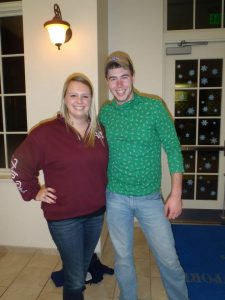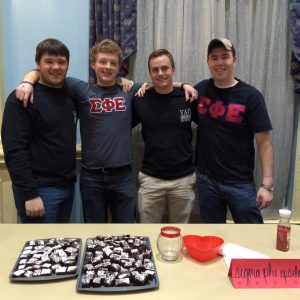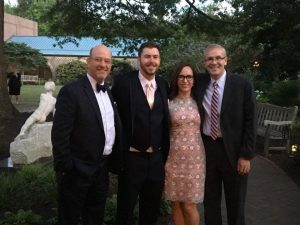College was my first time being around white people en masse. I attended a predominantly Black high school and a predominantly Black church, so all my pre-college spaces were filled with the familiarity and safety of Black culture. Space matters. In his book The Great Good Place, sociologist Ray Oldenburg refers to a “third space” as a place where people come together and interact outside of home or work/school (their first and second spaces). Cafés, coffeeshops, hair salons, and barbershops are examples of third spaces. People who occupy these spaces often feel that a part of their identity is valued and supported there.
For those who identify as members of underrepresented or marginalized groups, these spaces are extremely important. Counterspaces, a term often used in higher education, are “sites where deficit notions of people of color [or other marginalized groups] can be challenged and where a positive climate can be established and maintained” (Solorzano, 2000, p. 70). These spaces also facilitate adaptive responding, which has the overall goal of “protecting and enhancing the self-concept and, in doing so, promoting psychological well-being in marginalized individuals” (Case & Hunter, 2012, p. 260).
During my first year as a college student, I quickly got involved in three different campus organizations that served as counterspaces for me. As a Black student attending a predominantly white institution (PWI), I borrow the words of KerryAnn O’Meara to describe what these types of spaces meant to me: “I felt welcome, at home, and free of the constraints I’d encountered in both my primary [home] and secondary [school/classroom] spaces.” These feelings are a big part of why I stayed involved in these organizations throughout my four years in college.
So, in keeping with the consistency of threes, here are three ways that my three counterspaces/third spaces helped me find my way through college:
Finding My People
I thought I knew what I was getting into attending a PWI; I wanted a different experience in college than I had in high school. But I wasn’t prepared for the alienation I’d feel when my white peers would purposely avoid making eye contact or crossing paths with me. I wasn’t prepared for the moments of “did they really just say that?” Like the time the girls on my freshman hall chose “ghetto fabulous” as the hall’s theme for our welcome week activities and proceeded to ask me how to be ghetto. *stares into the camera Jim Halpertly*

The classic Jim stare into the camera
I grew up in the suburbs of Charlotte.
For those reasons and more, I was so thankful for the Black Student Coalition (BSC). The BSC was a space and place (there was also a physical house where students gathered) that felt like home on campus. I was able to meet and build relationships with other Black students, Black faculty and staff, and Black alumni. I spent so many days and nights at the BSC house having late night laughs with friends, learning about issues important to the Black community, attending homecoming cookouts, and planning the best parties. This space grounded me and provided stability in the face of the chaos of microaggressions and feelings of invisibility.
Finding My Voice
I’m an introvert…always have been, probably always will be. But growing up, my introversion was also equivalent to silence. Being a part of STRIDE was the beginning of changing that. STRIDE was a pre-orientation and peer mentoring program for incoming students of color. I always credit it as being the reason why I stayed at my alma mater. STRIDE gave me the opportunity to be formally and informally mentored by and to mentor other students of color.

Members of the STRIDE program at the Aggie Eagle Classic during my first year
My introversion caused me to be silent, to play small, and to shrink myself around others. My involvement in STRIDE put me in proximity to so many of my peers who let their light shine in various and unique ways, from representing the interests of students of color in student government to creating a slam poetry group and from speaking out against administrators who were treating students unfairly to advocating for new academic programs that would reflect the cultural diversity of the student body. Watching them and learning from them allowed me to become confident in my own voice and in my own light. It’s like Marianne Williamson said: “As we let our own light shine, we unconsciously give others permission to do the same. As we are liberated from our own fear, our presence automatically liberates others.”
Finding My Joy
Many PWIs create and perpetuate spirit-murdering experiences for Black students. “Spirit murder” is a term coined by legal scholar Patricia Williams (1987) to address how “racism is as devastating, as costly, and as psychically obliterating as robbery or assault” (p. 129). Education scholar Bettina Love applies spirit murdering to the educational experiences of Black and Brown students and, in a 2019 article, refers to spirit murder as “a slow death, a death of the spirit, a death that is built on racism and intended to reduce, humiliate, and destroy people of color.” As such, joy is a necessary tool for surviving and thriving. Joy is both resistance and resilience.

Me (far right) during my senior year with the other members of Shades of Brown
The Shades of Brown step team was my space of joy. It was my space to create, to collaborate, and to laugh…even through two-a-day or 7 am practices. No matter what type of foolery or shenanigans I had been dealing with earlier that day, stepping brought me back to myself. I was able to take off the mask that I felt I needed to wear to protect myself from the many methods of spirit murder—imposter syndrome, stereotype threat, and racial battle fatigue. And I was able to share the joy that I experienced in community with my teammates and with the larger campus. To quote Audre Lorde: “The sharing of joy, whether physical, emotional, psychic, or intellectual forms a bridge between the sharers which can be the basis for understanding much of what is not shared between them, and lessens the threat of their difference.” It is a lot like the steps we would create: different beats made of many voices, stomps, and claps that come together to create a unified sound.
Space matters in higher ed: “places of engagement where…perceptions of learning, teaching, knowledge, and identity are being challenged” (Savin-Baden, 2008, p. 7). And typically, the focus is on classroom spaces, but those are not the only spaces where learning happens.
The BSC, STRIDE, and Shades of Brown not only helped me find my way through college but also helped me find my way to my purpose as an educator. They were learning spaces as much as (if not more than) any classroom was. These experiences are the foundation of why I’m excited to do that work that I do: to create and maintain spaces that build community, encourage students to find and amplify their unique voices, and promote joy in the face of adversity.











